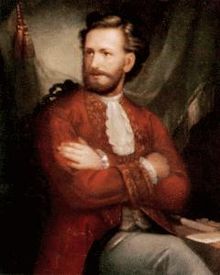Gabriel Cano de Aponte
Gabriel Cano de Aponte (* 1665 in Mora (Toledo) , Spain ; † November 11, 1733 in Santiago de Chile ) was a Spanish officer who served as governor of Chile from 1717 to 1733 .
Life
Origin and youth
Cano was born near Toledo to Joan Cano Ruiz and his wife Josefa de Aponte Carvajal into a wealthy aristocratic family.
He entered the service of the crown. Under King Charles II he fought in Flanders from 1690 to 1697 in the war against France and excelled in the capture of Namur . In the War of Spanish Succession , he joined the French forces under the future King Philip V of. He distinguished himself in the victory of the French against the Habsburgs at Stolhofen near Strasbourg as well as in the attack on Ghent . He married Maria Campos, a native of Brussels , who died in 1713.
In 1710 he went to Spain, fought in the campaign in Aragón , the battle of Saragossa and the capture of Barcelona . After the Spanish troops had fought largely in Landsknechts manner until then , the new king introduced a tighter organization with strict hierarchies, which he brought with him from France. Cano profited from this and rose in quick succession to field marshal and received the Order of Calatrava . In 1715 he was promoted to lieutenant general (Spanish: teniente general ).
Term of office as Governor of Chile
Taking office
On October 31, 1715 Philip V appointed him governor of Chile. On January 5, 1716, he married in Pamplona for the second time, Francisca Velas de Medrano Navarra y Puelles, with whom he went to Santiago. At the beginning of 1717 he embarked in Cádiz and reached the Río de la Plata in July . With him drove Bruno Mauricio de Zavala , who was appointed governor of Buenos Aires . Cano waited for spring to begin in October before daring to cross the Andes. On December 16, 1717 he made a solemn entry into Santiago de Chile and was received there the following day by the representatives of the Real Audiencia of Chile and introduced into his office.
Fight against smugglers and pirates
Cano had received instructions from Spain to stop smuggling by French and English ships and piracy by corsairs . However, the authorities generally lacked the support of the population in the fight against smugglers, who benefited from the low prices of duty-free contraband.
His nephew, Manuel de Salamanca , who had accompanied him from Spain, was appointed inspector general of the cavalry from Buenos Aires in early 1718 with new weapons and was supposed to support him in this task. In 1719 the fortifications in Concepción were expanded and the attacks of the privateer George Shelvocke were thrown back.
Negotiations with the Indians
Indigenous rebels attacked and destroyed a Jesuit mission on Chiloé in 1718 . A punitive expedition was ineffective. After that, people lived in peaceful coexistence until rumors of an impending Indian revolt began to circulate in 1722. In March 1723 there were actually attacks by the Indians on fortifications. With 500 soldiers, the Spaniards drove out the Indians under Salamanca. Then the situation calmed down again and resulted in a peace treaty in 1725 and a parliament of Negrete in 1727.
Infrastructure measures
Initial plans to connect the Río Mapocho and Río Maipo rivers were discussed but not pursued.
He achieved concrete practical improvements for the population in garbage disposal and street cleaning in Santiago as well as in fire prevention.
On July 8th, 1830, a severe earthquake struck Chile and destroyed large parts of Santiago. Since the first tremors were felt early, the personal injuries were limited, but most of the houses were affected, especially since the Mapocho was flooded a few days later.
character
Cano was vigorous and of a youthful appearance. He was particularly interested in equestrian games. He was also not averse to gallant adventures.
Detachment and death
On December 24th, 1731, King Philip V decided that Cano could retire back to Europe and be replaced by Bruno Mauricio de Zabala . However, Cano was only allowed to leave after the arrival of the successor due to new threatened Indian attacks and waited in Santiago for his replacement. On July 27, 1733, on St. James Day (Spanish: Santiago ), (according to other sources: in March), the 68-year-old fell from his horse and was seriously injured. His situation worsened over time, and on November 4, 1733, the Audiencia wrote a letter to the king that the governor was dying. Nothing was known in Chile about the whereabouts of the designated successor. Gabriel Cano de Aponte died on November 11, 1733. His tenure was the longest of any Spanish governor in Chile. Of all the heads of government in Chile, he was only surpassed by Augusto Pinochet .
literature
- Diego Barros Arana : Historia jeneral de Chile ( Spanish ), Volume 6. Rafael Jover, Santiago de Chile 1886, pp. 5-86 (accessed June 24, 2010).
- José Toribio Medina : Diccionario Biográfico Colonial de Chile. Imprenta Elzeviriana, Santiago de Chile 1906, pp. 165-166 .
Web links
Individual evidence
| personal data | |
|---|---|
| SURNAME | Cano de Aponte, Gabriel |
| BRIEF DESCRIPTION | Governor of Chile |
| DATE OF BIRTH | 1665 |
| PLACE OF BIRTH | Mora, Toledo , Spain |
| DATE OF DEATH | November 11, 1733 |
| Place of death | uncertain: Santiago de Chile , Chile |

